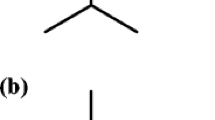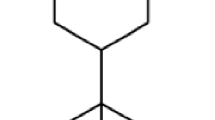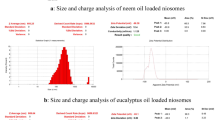Abstract
In this study, the essential oil (EO) from leaves of Croton linearis Jacq was extracted and characterized by GC/MS. The EO hydrophilic-lipophilic balance required (rHLB) for nanoemulsion (NE) development was determined by the Griffin’ method. For evaluating the larvicidal effect against Aedes aegypti, the preparation process of NE was optimized, using a central composite design. It was also evaluated the possible toxic effect of NE in nontarget species. The leaves of C. linearis contain 1.50% of EO, enclosing 61 volatile compounds, mainly eucalyptol (26.66%). The best surfactant, oil:water ratio (4.5–5.0-91.5; % w:w:w), allows to achieve the optimal NE, using a stirring speed of 800 rpm, the addition rate of 0.5 ml/min, and a stirring time of 30 min. NE (with particle size = 163 nm) showed a larvicide effect (LC50 = 17.86 μg/mL) more potent than the whole EO (LC50 = 64.24 μg/mL). NE showed neither hemolytic effect nor cytotoxicity, and it was classified as a nontoxic product, according to the OECD class toxicity test (IC50 > 2000 mg/kg). This product arises in a new green bio-larvicide that could be used for mosquito control.





Similar content being viewed by others
References
Alexander IC, Pascoe KO, Manchard P, Williams LAD (1991) An insecticidal diterpene from Croton linearis. Phytochemistry 30:1801–1803
Angajala G, Ramya R, Subashini R (2014) In-vitro anti-inflammatory and mosquito larvicidal efficacy of nickel nanoparticles phytofabricated from aqueous leaf extracts of Aegle marmelos Correa. Acta Trop 135:19–26
Anjali CH, Sharma Y, Mukherjee A, Chandrasekaran N (2012) Neem oil (Azadirachta indica) nanoemulsion -a potent larvicidal agent against Culex quinquefasciatus. Pest Manag Sci 68:158–163
Bai L, McClements DJ (2016) Extending emulsion functionality: post-homogenization modification of droplet properties. Processes 4:1–18
Balasubramani S, Rajendhiran T, Kumar MA, Kumari BDK (2017) Development of nanoemulsion from Vitex negundo L. essential oil and their efficacy of antioxidant, antimicrobial and larvicidal activities (Aedes aegypti L.). Environ Sci Pollut Res 24(17):15125–15133
Benelli G, Pavela R, Petrelli R, Cappellacci L, Canale A, Senthil-Nathan S, Maggi F (2018) Not just popular spices! Essential oils from Cuminum cyminum and Pimpinella anisum are toxic to insect pests and vectors without affecting non-target invertebrates. Ind Crop Prod 124:236–243
Benelli G, Pavela R, Petrelli R, Kamgang NF, Cappellacci L, Lupidi G, Quassinti L, Bramucci M, Sut S, Dall’Acqua S, Canale A, Maggi F (2019) Carlina oxide from Carlina acaulis root essential oil acts as a potent mosquito larvicide. Ind Crop Prod 137:356–366
Block S, Baccelli C, Tinant B, Van Mervelt L, Rozenberg R, Habib JJL, Llabrès G, De Pauw-Gillet MC (2004) Diterpenes from the leaves of Croton zambesicus. Phytochemistry 65:1165–1171
Braga IA, Valle D (2007) Aedes aegypti: insecticides, mechanisms of action and resistance [in português]. Epidemiologia e Serviços de Saúde 16(4):179–293
Cheng M, Chen H, Wang Y, Xu H, Hhe B, Han J, Zhang Z (2014) Optimize synthesis of glycyrrhetinic acid-modified chitosan 5-fluorouracil nanoparticles and their characteristics. Int J Nanomedicine 9:695–710
Conti B, Canale A, Bertoli A, Gozzini F, Pistelli L (2010) Essential oil composition and larvicidal activity of six Mediterranean aromatic plants against the mosquito Aedes albopictus (Diptera: Culicidae). Parasitol Res 107:1455–1461
Cutler SJ, Cutler HG (2000) Biologically active natural products: pharmaceuticals. CRC Press, New York
da Cunha SSL, Andrade GS, da Silva CK, Deitos FD (2014) Avaliação da atividade larvicida de extratos obtidos do caule de Croton linearifolius Mull. Arg. (Euphorbiaceae) sobre larvas de Aedes aegypti (Linnaeus, 1762) (Diptera: Culicidae). Biotemas 27:79–85
Delgado AV, González-Caballero F, Hunter RJ, Koopal LK, Lyklema J (2007) Measurement and interpretation of electrokinetic phenomena. Pure Appl Chem 309:194–224
Dias N, Moraes DFC (2014) Essential oils and their compounds as Aedes aegypti L. (Diptera: Culicidae) larvicides: a review. Parasitol Res 113:565–592
Finney DJ (1971) Probit analysis, Edn 3 edn. Cambridge University press, Cambridge
Freitas FP, Freitas SP, Lemosb GCS, Ivo JC, Vieira IJC, Gravina GA, Lemosa FJA (2010) Comparative Larvicidal activity of essential oils from three medicinal plants against Aedes aegypti L. Chem Biodivers 7:2801–2808
Gabrielson J, Lindberg N, Lindstedt T (2002) Multivariate methods in pharmaceutical applications. J Chemom 16:141–160
Griffin WC (1949) Classification of surface-active agents by HLB. J Soc Cosmet Chem 1:311–326
Han X, Parker TL (2017) Lemongrass (Cymbopogon flexuosus) essential oil demonstrated anti-inflammatory effect in pre-inflamed human dermal fibroblasts. Biochimie Open 4:107–111
Isman MS (2019) Botanical insecticides in the twenty-first century-fulfilling their promise? Annu Rev Entomol. https://doi.org/10.1146/annurev-ento-011019-025010
ISO 10993-5 (2009) International Organization for Standardization. Biological evaluation of medical devices- Part 5: Tests for in vitro cytotoxicity
ISO 22412 (2008) International Organization for Standardization. Particle Size Analysis: Dynamic Light Scattering (DLS)
Jimenez PC, Fortier SC, Lotufo TMC, Pessoa C, Moraes MEA, Moraes MO, Costa-Lotufo LV (2003) Biological activity in extract of ascidians (Tunicata ascidiacea) from the northeastern Brazilian coast. J Exp Mar Biol Ecol 287:93–101
Komaiko J, McClements DJ (2015) Low-energy formation of edible nanoemulsions by spontaneous emulsification: factors influencing particle size. J Food Eng 146:122–128
Lafourcade PA, Keita H, Pereira ST, Silva LE, Domingo RAL, Amazonas SMJ, Tavares CJT, Rodriguez AJR (2018) Cassia grandis lf nanodispersion is a hypoglycemic product with a potent a-glucosidase and pancreatic lipase inhibitor effect. Saudi Pharmaceutical Journal 27:191–199
Lomonaco D, Santiago GMP, Ferreira YS, Arriaga AMC, Mazzetto SE, Melec G, Vasapollo G (2009) Study of technical CNSL and its main components as new green larvicides. Green Chem. https://doi.org/10.1039/b811504d
Lu D, Rhodes DG (2000) Mixed composition films of spans and tween 80 at the air-water Interface. Langmuir 16:8107–8112
McClements DJ (2012) Advances in the fabrication of emulsions with enhanced functionality using structural design principles. Curr Opin Colloid Interface Sci 17:235–245
McClements DJ (2015) Food emulsions: principles, practices, and techniques, 3rd edn. CRC Press INC, Washington
Merino N, Berdejo D, Bento R, Salman H, Lanz M, Maggi F, Sánchez GS, García GD, Pagán R (2019) Antimicrobial efficacy of Thymbra capitata L. Cav. Essential oil loaded in self-assembled zein nanoparticles in combination with heat. Ind Crop Prod 133:98–104
Morais SM, Cavalcanti ESB, Bertini LM, Oliveira CLL, Rodrigues JRB, Leal-Cardoso JH (2006) Larvicidal activity of essential oils from Brazilian Croton species against Aedes aegypti L. J Am Mosq Control Assoc 22:161–164
Neves IA, Camara CAG (2012) Volatile constituents of two Croton species from Caatinga biome of Pernambuco – Brazil. Rec Nat Prod 6:161–165
OCDE 423 (2001) OECD, guideline for testing of chemicals. Acute Oral Toxicity-Acute Toxic Class Method 423:2012
Oliveira AE, Lobato DJ, Rodriguez AJR, Soares CRA, Rocha FC, Picanço SRN, Ferreira ARM, Santos K, da Conceição CE, de Oliveira RLA, Kelecom A, Fernandes PC, Tavares CJC (2016) Development of a Larvicidal Nanoemulsion with Pterodon emarginatus Vogel oil. PLoS One 11:e0145835
Ostertag F, Weiss J, McClements DJ (2012) Low-energy formation of edible nanoemulsions: factors influencing droplet size produced by emulsion phase inversion. J Colloid Interface Sci 388:95–102
Pavela R (2015) Essential oils for the development of eco-friendly mosquito larvicides: a review. Ind Crop Prod 76(2015):174–187
Pavela R, Benelli G, Pavoni L, Bonacucina G, Cespi M, Cianfaglione K, Bajalan I, Reza MM, Lupidi G, Romano D, Canale A, Maggi F (2019a) Microemulsions for delivery of Apiaceae essential oils-towards highly effective and eco-friendly mosquito larvicides. Ind Crop Prod 129:631–640
Pavela R, Pavoni L, Bonacucina G, Cespi M, Kavallieratos NG, Cappellacci L, Petrelli R, Maggi F, Benelli G (2019b) rationale for developing novel mosquito larvicides based on isofuranodiene microemulsions. J Pest Sci 92(2):909–921
Pequeno NF, Soto-Blanco B (2006) Toxicidade in vitro de plantas tóxicas: avaliação do teste de ação hemolítica. Acta Sci Vet 34(1):45–48
Pinho-da-Silva L, Mendes-Maia PV, do Nascimento GTM, Cruz JS, de Morais SM, Coelho-de-Souza AN, Lahlou S, Leal-Cardoso JH (2010) Croton sonderianus essential oil samples distinctly affect rat airway smooth muscle. Phytomedicine 17:721–725
Prophiro JS, Silva MAN, Kanis LA, Rocha LCBP, Duque-Luna JE, Silva OS (2012) First report on the susceptibility of wild Aedes aegypti (Diptera: Culicidae) using Carapa guianensis (Meliaceae) and Copaifera sp. (Leguminosae). Parasitol Res 110:699–705
Radulovic’ N, Mananjarasoa E, Harinantenaina L, Yoshinori A (2006) Essential oil composition of four Croton species from Madagascar and their chemotaxonomy. Biochem Syst Ecol 34:648–653
Rattan RS (2010) Mechanism of action of secondary insecticidal metabolites of plant origin. Crop Prot 29:913–920
Regnault-Roger C, Vincent C, Arnason JT (2012) Essential oils in insect control: low-risk products in a high-stakes world. Annu Rev Entomol 57:405–424
Ryan MF, Byrne O (1988) Plant-insect coevolution and inhibition of acetylcholinesterase. J Chem Ecol 14:1965–1975
Rodriguez AJR, Prada AL, Duarte JL, Keita H, da Silva HR, Ferreira AM, Sosa EH, Carvalho JCT (2017) Development, stability, and in vitro delivery profile of new loratadine-loaded nanoparticles. Saudi Pharm J 25:1158–1168
Saberi AH, Fang Y, McClements DJ (2013) Fabrication of vitamin E-enriched nanoemulsions: factors affecting particle size using spontaneous emulsification. J Colloid Interface Sci 391:95–102
Sharifi-Rad J, Sureda A, Tenore GC, Daglia M, Sharifi-Rad M, Valussi M, Tundis R, Sharifi-Rad M, Loizzo MR, Ademiluyi AO, Sharifi-Rad R, Ayatollahi SA, Iriti M (2017) Biological activities of essential oils: from plant Chemoecology to traditional healing systems. Molecules 22(1):E70
Silva SLC, Carvalho MG, Gualberto SA, Carneiro-Torres DS, Vasconcelos KC, Oliveira NF (2010) Bioatividade do extrato etanólico do caule de Croton linearifolius Mull. Arg. (Euphorbiaceae) sobre Cochliomyia macellaria (Diptera: Calliphoridae). Acta Veterinaria Brasilica 4:252–258
Smitt O, Högberg HE (2002) Synthesis of a prenyl bisabolene diterpene, a natural insecticide from Croton linearis, and of the bisabolene sesquiterpenes (−)-delobane and (−)-epidelobane. Tetrahedron 58:7691–7700
Solans C, Solé I (2012) Nano-emulsions: formation by low-energy methods. Curr Opin Colloid Interface Sci 17:246–254
Tadros T (2013) Encyclopedia of colloid and Interface science. Springer, New York
Throne JE, Weaver DK, Baker JE (1995) Probit analysis: assessing goodness-of-fit based on backtransformation and residuals. J Econ Entomol 88(5):1513–1516. https://doi.org/10.1093/jee/88.5.1513
Vitali LA, Beghelli D, Biapa NPC, Bistoni O, Cappellacci L, Damiano S, Lupidi G, Maggi F, Orsomando G, Papa F, Petrelli D, Petrelli R, Quassinti L, Sorci L, Zadeh MM, Bramucci M (2016) Diverse biological effects of the essential oil from Iranian Trachyspermum ammi. Arab J Chem 9(6):775–786
World Health Organization (WHO) (2005) Guidelines for laboratory and field-testing of mosquito larvicidal. World Health Organization Communicable disease control, prevention, and eradication. World Health Organization pesticide evaluation scheme. Geneva, Switzerland
World Health Organization (2016) Monitoring and managing insecticide resistance in Aedes mosquito populations. Interim guidance for entomologists. WHO/ZIKV/VC/16.1. WHO Press, 20 Avenue Appia, 1211 Geneva 27, Switzerland
World Health Organization (2018) Plan of action on entomology and vector control 2018-2023. 70th session of the regional committee of who for the Americas, Washington
Xu X, Al-Ghabeish M, Rahman Z, Krishnaiah YS, Yerlikaya F, Yang Y, Manda P, Hunt RL, Khan MA (2015) Formulation and process factors influencing product quality and in vitro performance of ophthalmic ointments. Int J Pharm 493:412–425
Funding
Authors want to thanks to Coordination for the Improvement of Higher Education Personnel (CAPES) and the Foundation for Research Support Foundation of the Amapá State (FAPEAP), Brazil. Grant number 23038.000516/2013-01.
Author information
Authors and Affiliations
Corresponding author
Ethics declarations
Conflict of interests
The authors declare that they have no conflict of interest.
Additional information
Responsible editor: Giovanni Benelli
Publisher’s note
Springer Nature remains neutral with regard to jurisdictional claims in published maps and institutional affiliations.
Rights and permissions
About this article
Cite this article
Amado, J.R.R., Prada, A.L., Diaz, J.G. et al. Development, larvicide activity, and toxicity in nontarget species of the Croton linearis Jacq essential oil nanoemulsion. Environ Sci Pollut Res 27, 9410–9423 (2020). https://doi.org/10.1007/s11356-020-07608-8
Received:
Accepted:
Published:
Issue Date:
DOI: https://doi.org/10.1007/s11356-020-07608-8




